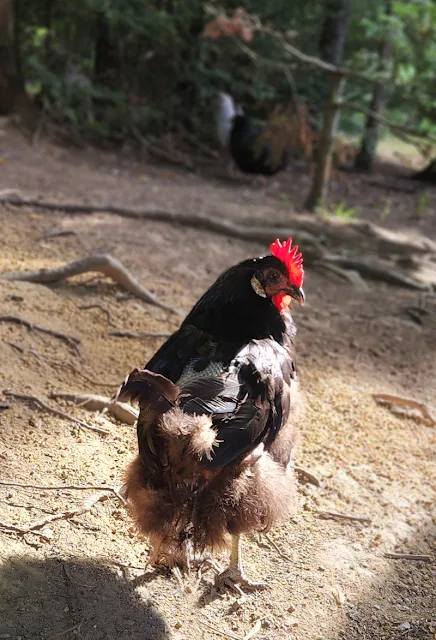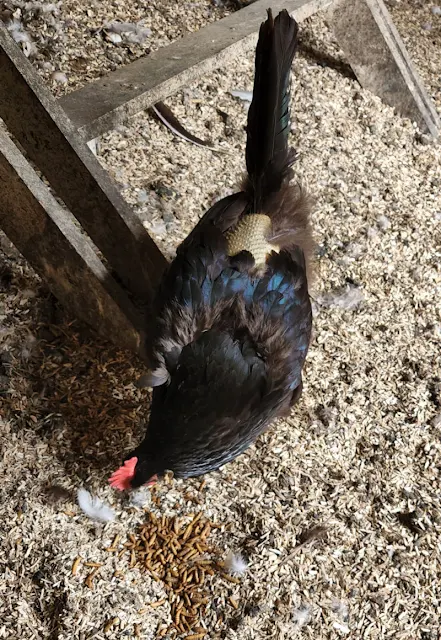When and Why Do Chickens Molt?
If you're new to chicken keeping, you might not realize that each fall, starting when they're around 18 months old (assuming they hatched in the spring), chickens will start to lose their feathers.
Although there are a variety of other reasons why your chickens might be losing their feathers including flock aggression, poor nutrition, mites, an over-zealous rooster or predator attack, stress, etc. if you start to notice feathers all over the ground in the late summer or early fall, most likely they're molting.
This is completely normal and nothing to worry about.
What is Molting?
The origin of the word "molt" comes from the Old English or Latin words meaning "to shed or fall out" usually as pertaining to feathers, fur, scales or an outer covering.
It's generally spelled "moult" in the UK and "molt" in the United States. But it's the same thing no matter how you spell it.
Molting is the process that birds, including chickens, go through to replace their old, broken and dirty feathers with healthy new ones before the cold weather sets in.
The feather loss always follows the same pattern on the bird, starting around the head and neck and then traveling down the body to the breast, abdomen, wings and finally the tail and vent area.
When and Why Do Chickens Molt?
Why Do Chickens Molt?
Since the predominant way chickens stay warm in the winter is to fluff out their feathers, having nice, clean, full new feathers heading into the cold weather is beneficial.
The feathers work to trap air warmed by their bodies in between their bodies and their feathers, creating a nice pocket of warm air to keep them warm.
Although your flock will come out of the molt looking beautiful with shiny, glossy, healthy feathers, the molt is not mainly for aesthetic reasons. And they'll look utterly pitiful while they're going through it.
It's probably a case of anthropomorphism on my part, but I always feel like my chickens are embarrassed about how bad they look while they're molting!
When Do Chickens Molt?
Generally in late summer to early fall, the shorter days will trigger the molt, although the exact timing of it can vary widely chicken to chicken. But adult chickens molt once a year.
If you hatch chicks in the spring, they won't molt that first fall, but will wait and experience their first molt the following year when they're roughly 18 months old.
Younger birds do experience a "juvenile molt" somewhere around 12 weeks old when they drop their original feathers and grow in their "big girl" feathers.
How Long Does Molting Take?
The length of time it takes for the molt to occur can also widely vary from bird to bird. The annual most can take weeks or months, depending on the individual chicken.
And it's not uncommon to still have some flock members molting well into winter.
But generally, the molt can last from one to three months.
Molting in Good Layers
In general, your good layers will start molting first and it will happen very quickly. I have some chickens that look fine one day and the next day, have lost nearly all their feathers.
But since new feather quills push out the old feathers, you will already see new feathers starting to grow in by the time the old feathers have fallen out.
Molting in Poor Layers
Your poor layers will likely hold off a bit longer and start molting later in the season.
And then they'll often seem to take forever to finish up. Some of my chickens barely look like they're even molting because they're going through the change so slowly - one feather at at time it seems like sometimes!
Do Chickens Lay Eggs While They're Molting?
Usually partway through the molt, a hen will stop laying eggs. She's using all her energy (and protein!) to grow in new feathers, so egg production will stop.
Some hens will then take a winter break and not resume laying until the following spring, while others will continue to lay eggs until the days get shorter.
When they do resume laying after the molt, they generally won't lay as many eggs, but their eggs will be a bit larger.
Fun fact: sometimes roosters will also be impotent while they're molting. Makes sense, you don't want baby chicks that time of year anyway.
It's very common for chickens to lose weight during the molt because the protein they're eating is going to new feathers, not maintaining body weight. And once a rooster has lost around 25% of his body weight, he will be impotent.
What Should I Feed my Molting Chickens?
Since chicken feathers are made of approximately 80-90% protein/keratin, 8 percent water and 1% water-insoluble fats, so providing your molters extra protein during their molt can help them regrow their feathers and not lose as much body weight in the process.
Some people like to switch to a higher-protein feed during the molting season. While that's perfectly fine to do, instead I like to provide my chickens alternative sources of protein in addition to their regular feed. These can include:
- Fish skins or scraps
- Grubs
- Mealworms
- Meat scraps
- Scrambled eggs
- Shellfish
- Sunflower seeds
Chickens are most definitely not vegetarian, but if you don't, or your family doesn't, eat meat or you don't feel right about feeding chickens traditional proteins, there are also lots of plants that contain high levels of protein as well as various herbs:
- Basil
- Dill
- Marjoram
- Oregano
- Parsley
- Spearmint
- Tarragon
Adding any of these foods to your flock's diet during the molting season will be beneficial in providing them a bit of extra protein.
You can also have some fun and make your chickens homemade high-protein treats like these Granola Energy Bites or Peanut Butter Snacking Cakes. Or how about some Protein Plant Smoothies?
How Else Can I Help my Molting Chickens?
Chickens seem to shy away from being handled while they're molting. Which makes sense - I would guess regrowing feathers is uncomfortable at the very least!
They'll tend to huddle in a corner, not be terribly active, etc. Just generally act like they're not loving life at the moment.
At first glance you might think they're sick, but most likely, they're just not feeling great about how they look!
Because regrowing feathers takes so much energy, your molting chickens will appreciate a bit of extra TLC during this time.
Things you can do to help your molting chickens include:
- Avoid handling your molting chickens as much as possible
- Make sure each chicken has enough space on the roosts to sleep without touching
- Put out extra feed and water to accommodate the extra nutrients they're using to regrow their feathers
- Be sure they have a nice warm spot out of the wind and in the sun to hang out in during the day since they will get cold much easier without a full set of feathers
- Watch for bullying or pecking issues due to the fact that new feathers contain blood in the center shaft just like dog toenails have in the quick, which can attract other flock members to pull the feathers out and eat them
- Be sure to give them apple cider vinegar in their water a few times a week to help with nutrient absorption and provide a bit of a health boost
- Give them as much free range time as possible so they can find their own supplemental protein in the form of worms, bugs, insects and weeds - and maybe even the occasional frog, snake, mouse or small bird (true story, my chickens once killed and ate a cardinal that got into their run)
But mostly, just be patient, because in no time, your chickens will have grown in a new set of beautiful, glossy feathers and be all ready for winter!

































